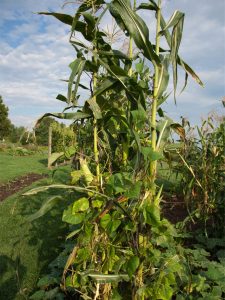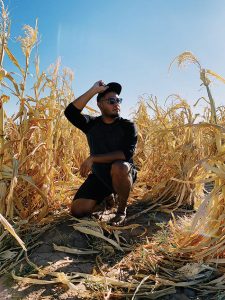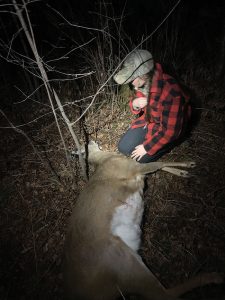Decolonizing What We Eat
Conversations with Indigenous farmers and thinkers about their pursuit of “honorable harvests.”
Three Sisters crops harvested by Native Food & Farming students at Vermont’s Sterling College
Teluisi Rebecca. I am a member of the Mi’kmaq Nation — the People of the Dawn. Our name for ourselves is L’nu. It is important that I state who claims me and my roots, so you understand what this land means to me, and my connection to it. I live in K’jipuktuk, Mi’kma’ki. Readers may know it as Halifax, Nova Scotia.
Far away as I am from the climate needed to grow avocados, I have a weekly ritual of buying one and letting it rot on my countertop before I use it. I don’t ever think about the waste it creates; I am disconnected from where that fruit comes from. And it only costs a buck fifty a week. You can’t even buy a coffee for that much anymore!
I understand and respect my relationship to the land when I am working it. I take care when weeding my garden in the summer. I plan my meals so as not to waste any of my homegrown produce. When I harvest wild berries, I use them before they mold, and I offer tobacco when I do any gathering or fishing. I never take too much when picking sacred plants, always leaving more than half of what I find.
And yet, I let that avocado rot week after week. Knowing there will always be a supply of mass-grown avocados has divorced me from the impact and effort that goes into growing that food.
My name is Katy. I’m an American woman of European ancestry — a disjointed identity that includes a Norwegian last name, Irish skin, and German ankles. After years of studying and writing about food systems, I’ve become ardently interested in Indigenous agriculture and worldviews. Recognizing my shortcomings as I work to decolonize my own mind, I study these traditions and tell these stories with respect and humility.
In writing this piece, Rebecca and I spent hours over Zoom discussing the definition of “sustainability” — and what it means to interact sustainably with our food system. A turning point in my own understanding of this idea was the book Braiding Sweetgrass by Robin Wall Kimmerer, a member of the Potawatomi nation, which I read while living in coastal Maine last summer.
Under blankets of kelp, mussels and sea snails clustered in the crevices between rocks along the shore. When the tide receded, I’d harvest mussels for dinner. My instinct was to take every mussel I found, but Kimmerer told me to ask permission. That’s the first step of what she calls the “honorable harvest.” When foraging or hunting, introduce yourself to the plant or animal you’re harvesting, ask permission, then “abide by the answer.” If the mussels didn’t easily come off the rocks when I pulled them, I took it as a “no.”
Never take the first ones you see, Kimmerer writes, in case there aren’t any more. And never take more than half. So I left some mussels for the green crabs and the birds, and enough so the mussels could reproduce. The honorable harvest is about paying attention to the ecosystem as a whole. Asking for permission requires us to slow down, assess what we’re harvesting, and see it as a life and a gift.
Kimmerer describes the difference between colonial capitalism’s market economy and many Indigenous societies’ gift economies, which consider land and the food that grows from it a gift to all. When we commodify food, we become disconnected from it and it loses its worth. But a gift comes with responsibility: to share with others, offer appreciation, and nurture the source of the gift.
In the hopes of learning a different way of relating to food, we spoke to a number of Indigenous people who farm, hunt, and gather about Indigenous wisdom, lifeways, and agricultural practices in use today. Sewn through the ideas of everyone we spoke to was a worldview that informs a reciprocal approach to agriculture and nature as a whole, one that values intergenerational knowledge and work, reverence and respect.
“The nucleus of our sustainability ethic is in how we look at the world, not in specific planting or husbandry techniques,” writes Chris Newman, a Black and Indigenous farmer, in his 2020 essay “Indigenous Agriculture: It’s Not The How, It’s the Why.” Newman is an enrolled member of the Chopitco band of the Piscataway Indians.
He founded Sylvanaqua Farms in Virginia’s Northern Neck peninsula, south of the Potomac River, where he raises grass-fed cattle, chicken, laying hens, and pork on about 15 hectares of pasture. But what he produces and how he produces it, he said, is less important than the why.
The first white folks to show up here — like John Smith — did not recognize it as a food-producing landscape. He thought he’d died and gone to the Garden of Eden.
“Us being Indigenous and people of color, we look at ourselves more as land and water protectors who happen to produce food,” Newman told Katy last summer. When asked why he raises cattle specifically, he said that cows play a role in restoring the landscape. The meat itself is less important than the role the animal plays in the restorative process. “What role does this animal and this plant have in protecting this landscape and protecting the water that runs through that landscape?”
At Sylvanaqua, he combines intensive agriculture — like producing pastured meat and eggs — with Indigenous agroforestry, the practice of planting a beneficial combination of native trees, shrubs, and other food plants. His goal is to restore the landscape while feeding large communities of people in the area. He’s building a large-scale collective farming operation modeled after the expansive foodsheds managed by the region’s Piscataway people before colonization.

A planting of Three Sisters crops
“If you were to come into my neck of the woods back in… [the] early 1500s maybe, you would not have found a farm,” Newman said in his keynote speech at the Young Farmers Leadership Convergence last year. “You would have found a gigantic, diverse, beautiful, food-producing agroecology centered around the rivers, that was so big, so grand, so productive, that the first white folks to show up here—like John Smith—did not recognize it as a food-producing landscape. He thought he’d died and gone to the Garden of Eden.”
Many Indigenous populations around the world use agricultural systems that protect biodiversity while producing and harvesting food, he notes. “Protecting the environment always comes first. A protected environment will always provide.”
For example, the Heiltsuk Nation in Bella Bella, BC, have long hand-planted and managed kelp forests on shorelines to expand spawning grounds for herring. The fish are not forced into living there, but invited. Not controlled, but encouraged. These kelp forests protect biodiversity in the area by feeding an entire ecosystem: salmon, wolves, bears, and orca whales, in addition to humans.
“How do we feed people from the landscape? One way is to say ‘the market wants X’ so we are going to grow these commodities…, subdue this land, tame the wilderness and force it to feed us,” Newman said. “Or there is the Indian way, which is acknowledging what likes to grow here and grow there, and massaging the landscape to help it do its job.”
Through a sometimes spotty internet connection, Lonnie Yazzie told Rebecca stories tucked in stories — about his life, history, and language. He explained that when there isn’t a pandemic, he’s a cook in a restaurant in a casino. Yazzie is two-spirit and Diné (a member of the Navajo Nation) from Leupp, AZ.
Like most people in their twenties, he’s a savvy social-media user with a beautiful Instagram grid. Scrolling through, we saw sweeping desert landscapes and sunsets, and close-ups of husked corn in a rainbow of colours. Photos showed several generations of his family working together to grind the kernels and make “kneeldown bread.” He documents the process of clearing the fields and prepping them for next season. It’s all part of a cycle. Every person and plant has a place and role.
The Diné have cultivated this land for centuries. They’re one of many Indigenous nations in North America who grow the Three Sisters: an interplanted garden of corn, beans, and squash. The corn provides a stalk for the legumes to climb, and the squash plant’s broad leaves keep the ground moist while shading out weeds. Meanwhile, beans and peas bring symbiotic bacteria that fix atmospheric nitrogen in the soil, fertilizing all three.

Lonnie Yazzie in his family’s corn field.
Both Indigenous and non-Indigenous science confirm that a Three Sisters garden produces more food per area planted than if corn, squash, or beans are grown alone. And the sisters complement each other in the human diet as well as they do in the soil. Dried corn’s starchy carbohydrates provide energy through the colder seasons; legumes are rich in protein and dietary fiber; and squash supplies a host of vitamins and minerals.
Although Yazzie and his family come from a tradition of agriculturalists, they only began farming in earnest in 2012, as a way to supplement their own diet.
“We had to find a way to make what we had work,” he said, alluding to both his family’s farm and his people’s history with colonization, including the Long Walk — the forced relocation of thousands of Diné in the 1860s. This resilience in the face of attempted genocide is a point of solidarity for Indigenous peoples across North America.
The Native American Boarding Schools and Canadian Residential Schools of the 19th and 20th centuries were another attempt at genocide, intentionally erasing Indigenous languages and cultural traditions in the name of Eurocentric cultural assimilation. Languages of relationship and ceremony were forcibly replaced by English and Christianity: a noun-heavy language and worldview that describes non-human plant and animal species with the pronoun “it.”
“It robs a person of selfhood and kinship, reducing a person to a mere thing,” writes Kimerrer. “[In Potawatomi] and most other Indigenous languages, we use the same words to address the living world as we use for our family.” If we see the land as “it” instead of kin, it lessens the responsibility to maintain a reciprocal relationship.
Language can and does impact worldview. For Yazzie, this could mean he sees the world through both a Diné lens and an English one. He was raised traditionally, learning and speaking Diné bizaad, and would sometimes pause in conversation because there wasn’t an English word that conveyed the concept he was trying to explain. Many Indigenous languages contain what Kimmerer refers to as “the grammar of animacy.” She uses the example of puhpowee, an Anishinaabe word that translates to “the force which causes mushrooms to push up from the earth overnight.”
You treat plants like children. You take care of them, and then one day they will take care of you.
This past year, Yazzie and his family planted and grew all different colours of corn, squash, and melons. Yazzie explains the Diné farming philosophy: “You treat plants like children. You take care of them, and then one day they will take care of you.”
This philosophy is reflective of what James Skeet, a Diné man who runs Spirit Farm in Vanderwagen, NM, calls “Indigenous regenerative intelligence.” The term “regenerative agriculture” refers to practices that seek to restore soil health through small-scale diversified farming, in contrast to the large-scale monocultures that dominate our food system. The term is relatively new, but many regenerative agriculture principles have been passed down by Indigenous people for generations (an intellectual debt the movement often fails to acknowledge).
At Spirit Farm, Skeet uses Indigenous tradition to guide regenerative practices like microbiological composting that will heal the soil on his land. “Indigenous people have always had this organic mindset that all things are sacred,” he said in a podcast with Duke Sanford World Food Policy Center. “Nature is to be respected and copied. Time is not linear but circular.”
Yazzie recounted one of his favourite memories from the last season. The irrigation setup on his family’s farm came apart, soaking the earth and creating a mud pit that he had to wade into to fix the system. The failing of this system could have meant the loss of his family’s supplemental food, and yet Yazzie was able to laugh about it. Everyone was there and he volunteered to jump in. As with all the ways his community and family make it work, he captured it through a cell phone camera. According to Yazzie, “you’ve got to be modern to be traditional.”
Hannah Martin grew up picking sweetgrass in her traditional territory of Taqamiju’jk, Mi’kma’ki (also known as Tatamagouche, NS). Sweetgrass is one of several sacred medicines that grow in brackish soil; it’s used for a variety of ceremonies. This single act of ceremony was one of the only land-based activities she took part in regularly, but it helped shape a deep understanding of stewardship and the responsibility she had to the land.
She speaks passionately about who she is descendant from, where her grandparents lived, how they learned to work a trapline. As a full-time student, Martin learned about land stewardship in the classroom, but had very little hands-on experience until recently. She and her brother now own a woodlot. She spends time walking through the forest, getting to know the land and her relations: from the trees, to the deer, to the rabbits. She walks, listens, and learns. “Your relationship to food is sacred,” she said. “Eating food is a spiritual relationship.”
Everything is intentional, she told us. Whether you’re gathering sweetgrass or hunting, it is an intentional act—you are taking it from where it is supposed to be. The process fosters a strong sense of humility. That humility keeps you in check, she said, and makes a person aware of their impact on the land. Martin thinks people are disconnected from where their food comes from, like Rebecca and her avocados.

Hannah Martin with the lentuk she harvested in 2020.
This past year, Martin harvested her first lentuk, a deer. She walked us through the process of shooting the animal and sitting with it after it died: the emotions she experienced and the tears she cried; the profound respect she felt for the deer; the lock of her hair she offered as a “thank you” to the animal for its life. Her brother talked her through the steps of cleaning it: where to cut, what to leave for animals like ravens to eat. Nothing went to waste. She carried the deer out of the woods and saved the hide — she intends to learn how to cure it — and butchered the animal herself. She shared the meat with friends and family.
“It felt like coming home,” she said. “The source of all of our traditions comes from the land.”
In many ways, Martin follows the principles of the honorable harvest. The story of harvesting a deer may read as violent and gruesome to some, but according to Martin, it put the impact of “taking” at the forefront of her mind. Whether she is picking mushrooms, harvesting medicines, or hunting lentuk, she is reverent of — and in relationship with — nature’s gifts at each step.
Hunting lentuk requires more time, attention, and observation than purchasing an avocado from the supermarket. We often don’t know whose hands planted the pit, pruned the tree, harvested the fruit, or washed, packaged, shipped, and stocked it on the shelf. The transactional nature of purchasing food through a convoluted supply chain ends the relationship before we even consume it. Is that why we don’t mind letting the avocado rot? After all, it’s only worth a buck fifty. Being more connected to our food creates a more respectful and reciprocal relationship with the natural world — we waste less when we care.
“When there is no gratitude in return — that food may not satisfy,” Kimmerer writes. “It may leave the spirit hungry while the belly is full. Something is broken when the food comes on a Styrofoam tray wrapped in slippery plastic, a carcass of a being whose only chance at life was a cramped cage. That is not a gift of life; it is a theft.”
Print Issue: Spring/Summer 2021
Print Title: In Search of Honorable Harvests
